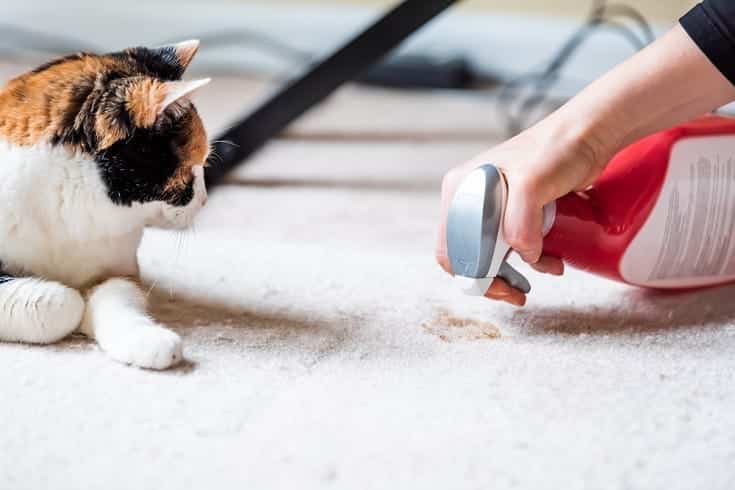It’s an unfortunate reality of owning pets; there are going to be messes that you have to clean up. Rather than get upset, it’s best to simply take action. Most of the time, you’re probably going to encounter pee or poop. Less often, you’ll discover that your cat has puked on the floor. If you’re really lucky, the messes will be contained to the parts of your home that have hard flooring.
But if you’re reading this article, that probably wasn’t the case. Of course, your cat just had to puke on the carpet. But don’t fret! We have three easy solutions for you that will help you clean up that vomit quickly and get back to your regular scheduled programming.
The Top 5 Tips & Tricks
1. Don’t Let It Sit
The number one rule of cat puke is to clean it up right away! The longer you allow it to sit, the worse it’s going to get. Granted, sometimes, we have no control over this. If you were at work all day and you just came home to discover a pile of puke on the carpet, well, you’re out of luck. Still, you should clean it the moment you discover it to reduce the impact it will have.

2. Dry It Up
When you first discover the vomit, you don’t want to start immediately dousing it with cleaners and solutions. Instead, you need to dry up as much of it as you can, taking care not to push any of it into the carpet more. Start with paper towels and allow them to gently soak up the vomit. Use only light pressure; otherwise, you’ll squish the vomit into the carpet and make it harder to remove.
3. Effective Household Cleaners
Your first line of defense will be the cleaners that you already have in your home. Dish detergent, salt, warm water, rubbing alcohol, and vinegar can make a very effective cleaner that will remove the smell and stains.
You can create the solution by dissolving 1 tablespoon of salt into 2 cups of warm water. Then, add in the remaining ingredients: ½ cup of white vinegar, 2 tablespoons of rubbing alcohol, and 1 tablespoon of dish detergent.
4. Pet Products
If household cleaners don’t cut it, you’ll need to step your game up and use something a bit stronger. Pet-specific products are made to remove the odors that your pets cause, including cat vomit.
- ADVANCED ENZYMATIC CLEANER - Penetrates the most stubborn smells and stains at the deepest molecular...
- FOR ANY MESS, ON ANY SURFACE - This pet odor eliminator cleans your carpets, floors, furniture,...
- FRESH, NATURAL ODOR - Our unique formulation doesn't rely on dangerous or unpleasant chemical...
The Hepper Advanced Bio-Enzyme Pet Stain & Odor Eliminator Spray is our favorite enzyme cleaner out there. It permanently removes even the very worst kitty stains and smells, leaving your home fresh and clean! Click here to learn more about this amazing product and get yourself a bottle.
At Catster, we’ve admired Hepper for many years, and decided to take a controlling ownership interest so that we could benefit from the outstanding products of this cool cat company!
Once the bulk of the vomit has been dried up with paper towels, soak the area with the Oxy-Fast spray. Let it sit for about 5 minutes, then blot it dry with a clean cloth or paper towel. Repeat this process for more effective results.
5. The Power of Baking Soda
Whether you’re using pet-specific cleaners or the products that were available already in your home, you’ll need to enlist the help of baking soda. After you’ve cleaned up the vomit using your preferred cleaner, cover the affected area with dry baking soda. Allow the baking soda to sit for 1 to 2 hours so it can soak up the moisture. You’ll start to see it clump together when it’s ready. Vacuum up the excess baking soda, and your carpet should be dry and odor-free. Repeat this step if necessary.

The 3 Ways to Clean Cat Vomit Out of Carpet
We’ve covered the very basics of which household cleaners and pet-specific products you can use to clean cat vomit out of your carpet, but let’s take a closer look at the steps you need to take.
1. Use Household Cleaners
Since you already have a host of household cleaners in your home, they’re the obvious first choice for cleaning up cat vomit. Before using a household cleaner, ensure you’ve soaked up as much of the wet vomit as possible.
Soak the area with the alcohol/salt/vinegar solution you’ve created. Allow it to sit for 5-10 minutes. Then, blot it dry with a towel or paper towel. The stain and odor should be eliminated. If not, you’ll need to repeat the process. Should you repeat this process several times without success, it’s time to try a pet-specific odor eliminator.
2. Use a Pet Odor Eliminator
Pet odor eliminators contain special chemicals and enzymes that are specifically meant to eliminate the odors your pet leaves behind when they make a mess. These products are incredibly easy to use. Just spray the cleaner on the stain, let it sit, then blot it dry. Repeated soaking can produce even better results. For stubborn stains and smells, several soakings might be necessary.

3. Use a Commercial Carpet Cleaner
If you’ve tried everything and just can’t seem to eliminate the smell and stain of your cat’s vomit, it’s time to bring in the big guns. Commercial carpet cleaners are available for rent, and they can do some serious work on carpet stains. Use a pet-specific carpet cleaning solution in the cleaner, then let the machine do the work. While you’re at it, you might as well clean all the carpets in your house since you’re paying for the rental anyway!
Conclusion
It’s never a good feeling to find the vomit that your cat left on the carpet. But it’s even worse when it leaves behind a stain or an unpleasant odor. Luckily, cleaning up cat puke doesn’t have to be an arduous task. If you use the right cleaners and chemicals, it should be a pretty simple process. Should it prove to be harder than expected, you can always call in the cavalry by renting a commercial carpet cleaner and letting the machine do all the heavy lifting.
You might also like:
- 4 Natural Home Remedies to Treat Cat Vomiting: Vet-Approved Methods
- 10 Best Cat Urine & Odor Removers (Enzyme Cleaners) – Reviews & Top Picks
Featured Image Credit: Kristi Blokhin, Shutterstock












